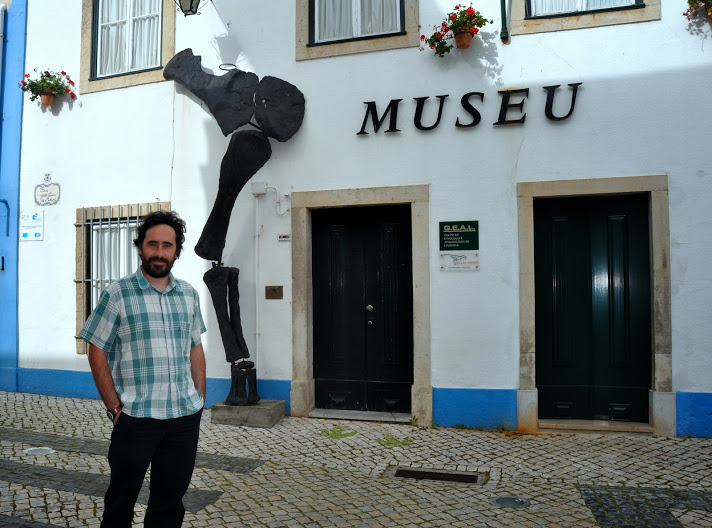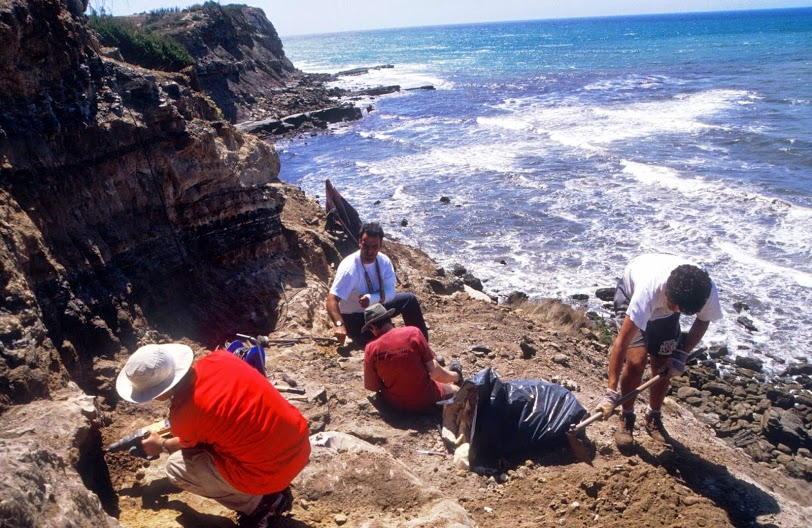11-05-2014
Zby atlanticus é o nome da nova espécie de dinossauro do Jurássico Superior com 150 milhões de anos descoberto na Lourinhã.
Este dinossauro que foi descoberto em 1996 pelo paleontólogo Octávio Mateus da Faculdade de Ciências e Tecnologia da Universidade Nova de Lisboa e também colaborador do Museu da Lourinhã é agora reconhecido como um novo género e espécie para a Ciência.

Deste dinossauro saurópode foi escavada uma pata dianteira (braço), um dente e um osso da cauda, em 1996, 2000 e 2002, na localidade de Paimogo, a norte da Lourinhã, perto do local de onde também foram escavados ovos. Este é um saurópode de grandes dimensões e se estivesse completo estima-se que teria 18 a 19 metros de comprimento.
O Zby é classificado como parte do grupo dos saurópodes turiassauros, inicialmente descobertos em Espanha ao contrário de outros dinossauros de Portugal que têm afinidades com espécies dos Estados Unidos. Os turiassauros, que foram originários na Ibéria que na altura era uma ilha, eram dinossauros herbívoro de pescoço longo, mas de dentes mais largos que a maioria dos outros saurópodes.
Na primeira identificação destes ossos pensou-se que se tratava de um género existente em Teruel, Espanha, um Turiasaurus, mas agora verifica-se que é uma espécie e um género distinto com base em diferenças anatómicas nos ossos dos membros recebendo, por isso, um novo nome: Zby atlanticus. O nome de género é em honra do paleontólogo Georges Zbyszewski (1909 - 1999) que trabalhou muitos anos em Portugal. Este cientista de origem russa dedicou toda a sua carreira ao estudo da geologia de Portugal e marcou a paleontologia nacional. Foi o autor da importante obra “Os Dinossauros de Portugal” publicada em 1957 em conjunto com Albert de Lapparent. O nome do dinossauro é o diminutivo pelo qual este cientista era muitas vezes tratado e tem a particularidade de ser um dos nomes mais curtos de dinossauros, com apenas três letras e nenhuma vogal: Zby. O epíteto específico, atlanticus, é devido à localidade de Paimogo que tem uma vista cénica para o Oceano Atlântico e porque foi a formação deste oceano que influenciou a existência de tantos dinossauros em Portugal.
O estudo foi publicado na prestigiada revista científica Journal of Vertebrate Paleontology por Octávio Mateus com os paleontólogos ingleses Philip Mannion e Paul Upchurch, do Imperial College e do University College of London, respectivamente. Os ossos originais estão no Museu da Lourinhã e uma réplica encontra-se na fachada deste museu, o que o torna este espécime muito fotografado. Recorde-se que em Março passado, este paleontólogo anunciou uma outra nova espécie de dinossauro, mas carnívoro, o Torvosaurus gurneyi com Christophe Hendrickx, também da Faculdade de Ciências e Tecnologia da Universidade Nova de Lisboa.

---
Zby atlanticus is the name of a new species of dinosaur from the Late Jurassic, 150 million years old, discovered in Lourinhã, Portugal.
This dinosaur, discovered in 1996 by the paleontologist Octávio Mateus, professor at the Faculdade de Ciências e Tecnologia (Faculty of Science and Technology) of the Universidade Nova de Lisboa (New University of Lisbon) and collaborator of the Museum of Lourinhã, has now been described as a new genus and species. The study was published in the prestigious scientific journal Journal of Vertebrate Paleontology by Octávio Mateus with the English paleontologists Philip Mannion and Paul Upchurch, from Imperial College London and University College London, respectively.
From this dinosaur, a forelimb, one tooth, and a bone from the tail were discovered in 1996, 2000, and 2002, at the Paimogo locality, north of Lourinhã, in Portugal, close to a site where dinosaur eggs from another species had been previously discovered. This dinosaur is a sauropod of large dimensions, with an estimated length between 18 and 19 meters.
Zby is classified within the turiasaur sauropods, first discovered in Spain and it differs from other dinosaurs found in Portugal, which share affinities with North American species. Turiasaurs appear to have been restricted to Iberia, which at that time was an island, and were long-necked, plant-eating dinosaurs, with larger teeth than the majority of other sauropods.
Initially, these bones were thought to belong to Turiasaurus, a sauropod genus found in Teruel, Spain, but it is now known to represent a distinct genus and species based on anatomical differences in the limb bones, thus receiving a new name: Zby atlanticus. The genus name honors the geologist Georges Zbyszewski (1909-1999), who worked for many years in Portugal. This scientist, of Russian origin, dedicated his career to the study of the geology of Portugal and left his mark on Portuguese paleontology. He authored the important work “The Dinosaurs of Portugal”, published in 1957 together with Albert de Lapparent. The name of the new dinosaur is the nickname by which he used to be often called, and has the peculiarity of being one of the shortest genus names of dinosaurs, with only three letters and no vowels: Zby. The specific name, atlanticus, refers to the scenic view overlooking the Atlantic Ocean in the locality of Paimogo where it was discovered, and because it was the formation of this ocean that influenced the existence of such a rich dinosaur fauna in Portugal. This new species was found near the area where other giant sauropod dinosaurs, Lusotitan and Dinheirosaurus, were collected, and these animals lived alongside other herbivorous dinosaurs (including the stegosaur Miragaia), as well as meat-eating dinosaurs.
The original bones are on display at the Museum of Lourinhã in Portugal and a replica can be found in the University of Bristol, UK, and at the Saurier Museum in Aathal, Switzerland. In March, Mateus announced another new species of dinosaur, the meat-eater Torvosaurus guerneyi, with Christophe Hendrickx, also from the Faculty of Science and Technology of the New University of Lisbon. These discoveries are adding to our knowledge of dinosaur evolution, and help us to understand how different regions of the world were connected in the past. They also continue to demonstrate the rich dinosaur fauna of Portugal 150 million years ago.